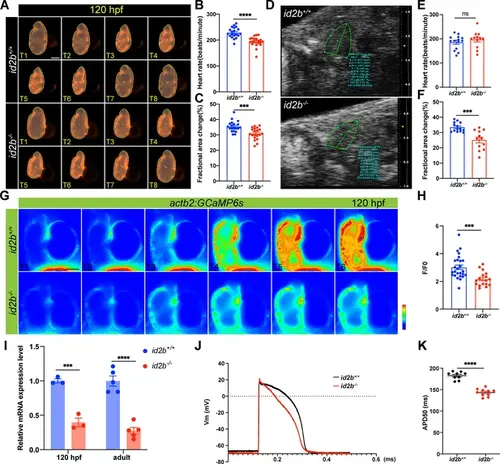Fig. 5
- ID
- ZDB-FIG-250819-17
- Publication
- Chen et al., 2025 - Contraction-induced endocardial id2b plays a dual role in regulating myocardial contractility and valve formation
- Other Figures
- All Figure Page
- Back to All Figure Page
|
Reduced cardiac contractile function and compromised calcium handling in id2b-/- mutants. (A) Time-lapse imaging (from T1 to T8) illustrates the cardiac contraction-relaxation cycle of 120 hr post-fertilization (hpf) id2b+/+ and id2b-/- hearts carrying myl7:mCherry. (B and C) id2b-/- larvae (n=20) display a significant decrease in heart rate and fractional area change compared to id2b+/+ (n=20). (D) Echocardiograms of adult id2b+/+ and id2b-/- hearts. (E and F) id2b-/- fish (n=12) exhibit reduced cardiac contractile function with preserved heart rate compared to id2b+/+ (n=14). (G) Time-lapse imaging illustrates the calcium dynamics of 120 hpf id2b+/+ and id2b-/- hearts carrying actb2:GCaMP6s. (H) Ratio of maximal fluorescence intensity (F) over basal fluorescence intensity (F0) of GCaMP6s signal. n=(26, 17). (I) Quantitative real-time PCR (qRT-PCR) analysis of cacnα1c mRNA in id2b+/+ and id2b-/- hearts at 120 hpf (N=3 biological replicates, with each sample containing 500–1000 embryonic hearts) and adult stage (N=5 biological replicates). Data were normalized to the expression of actb1. (J) The action potential of ventricular cardiomyocytes in adult id2b+/+ (n=9) and id2b-/- (n=9) hearts. (K) Statistical data showed a notable difference between id2b+/+ and id2b-/- accordingly. Data are presented as mean ± s.e.m. p-values were calculated by unpaired two-tailed Student’s t-tests. ***p<0.001, ****p<0.0001, ns, not significant. Scale bars, 50 μm. |

